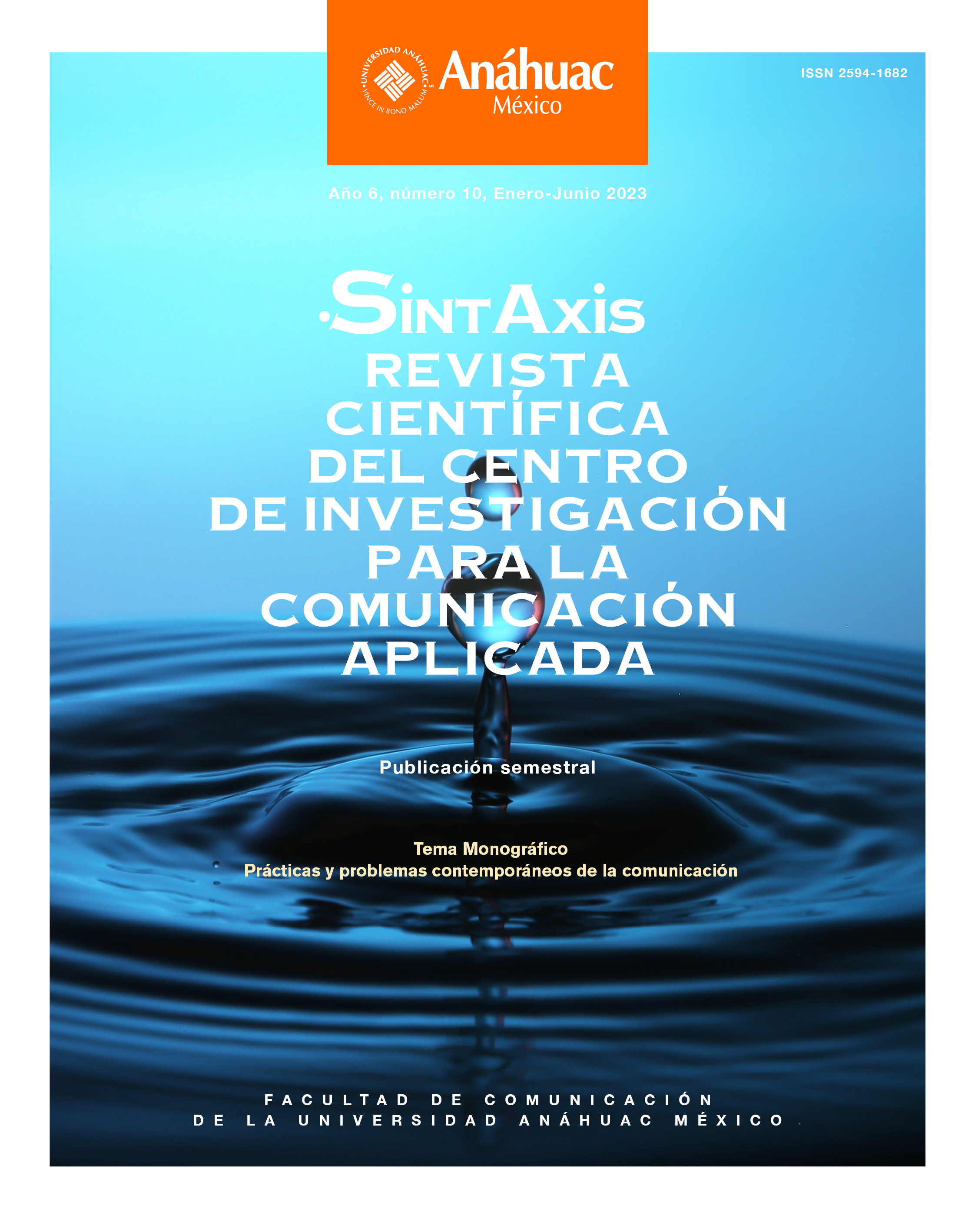State of organizational communication in a scientific re search and technology consortium
Main Article Content
Abstract
This article deals with organizational communication within a scientific and technological research consortium and its relationship with project management. From a mixed approach and a systemic perspective, the objective was to diagnose the state of organizational communication and its relationship with project management carried out within the framework of the Gulf of Mexico Research Consortium (CIGOM), between 2018 and 2021. The research was developed through from the review of the foundational documents of the consortium, the participant observation records and a questionnaire to a representative sample of consortium members in 2021. Evidence of greater communication activity in the internal sphere was found, which has benefited the operation of the consortium, and less activity abroad, this being an area of essential development in the immediate future. The management of the consortium showed better evaluations in terms of leadership, motivation, satisfaction and belonging, but not for aspects such as control, evaluation or adjustment processes and improvements related to these.
Downloads
PLUMX Metrics
Article Details

This work is licensed under a Creative Commons Attribution-NonCommercial-NoDerivatives 4.0 International License.
The author keeps the property rights with no restriction whatsoever and guarantees the magazine the right to be the first publication of the work. The author is free to deposit the published version in any other medium, such as an institutional archive or on his own website.
References
Alvarez, E., Miranda, C. E., y Molina, L. (2016). La Comunicación Pública de la Ciencia y la Tecnología para el Manejo Integrado de Zonas Costeras en Cuba. Memorias Del XIII Congreso Latinoamericano de Investigadores de la Comunicación, Comunicación Popular, Comunitaria y Ciudadanía, 81-88.
https://www.alaic.org/wp-content/uploads/2022/03/GT8.pdf
Álvarez, R., Contreras, C., y Contreras, J. (2012). Análisis de los consorcios tecnológicos empresariales en Chile. Estudios Públicos, 126. https://doi.org/10.38178/cep.vi126.309
Andrade, H. (2005). Comunicación Organizacional Interna: Proceso, Disciplina y Técnica. Netbiblo, S.L.
Arévalo, R. I. (2018). Perspectivas de la comunicación integral para las organizaciones en México: una visión de sus líderes. Razón y Palabra, 22, 760-777. http://revistas.comunicacionudlh.edu.ec/index.php/ryp%0APerspectivas
Arévalo, R. (2022). El valor de la comunicación organizacional: una visión desde los profesionales, académicos y consultores. Sintaxis, 8, 12-31. https://doi.org/10.36105/stx.2022n8.01
Arévalo, R. (2016). La gestión de la comunicación en la construcción de capitales para las organizaciones. V Congreso Iberoamericano de Comunicación “Comunicación, Cultura y Cooperación” AE-IC, 20-34.
http://www.fm-house.com/wp-content/uploads/2014/12/I-Congreso-Edificios-Inteligentes1.pdf#page=238
Busco, C., Retamal, R., y Rodríguez, D. (2008). Consorcios Tecnológicos. Buenas prácticas y lecciones aprendidas. https://www.conicyt.cl/pia/files/2012/08/InformefinalKEAConsorcios.pdf
Camarena, J. (2016). La Organización Como Sistema: El Modelo Organizacional Contemporáneo. Oikos Polis, Revista Latinoamericana de Ciencias Económicas y Sociales, 1(1), 135-174. http://www.scielo.org.bo/pdf/rlces/v1n1/v1n1_a05.pdf
CIGoM. (2020). Consorcio de Investigación del Golfo de México. Proyecto Del Fondo de Hidrocarburos de Conacyt/Secretaría de Energía. https://cigom.org/
CIMAT. Consorcios. https://www.cimat.mx/es/consorcios-conacyt
Conacyt. (2020). Consorcios. https://www.conacyt.gob.mx/index.php/consorcios
Conacyt México (@Conacyt_MX). (2021). La Dra. @ElenaBuylla encabezó la presentación de la obra “Regiones, especies y ecosistemas vulnerables ante derrames de petróleo de gran escala. [Imagen adjunta] [Tweet]. Twitter. https://twitter.com/Conacyt_MX/status/1448781377164349440
Consorcio de Investigación del Golfo De México (CIGoM). (2021). Informe Técnico Final Etapas 1,2 y 3. Proyecto No: 201441 Implementación de redes de observaciones oceanográficas ( físicas , geoquímicas , ecológicas ), para la generación de escenarios ante posibles contingencias relacionadas a la exploración y producción de hidorcarburos.
Frandsen, F., Johansen, W. (2017). Strategic Communication. The International Encyclopedia of Organizational Communication, 2250-2258. https://doi.org/10.1002/9781118955567.wbieoc194
Gonsalves, A. (2014). Lessons learned on consortium-based research in climate change and development. CARIAA Working Paper #1. www.idrc.ca/cariaa
Grover, N. (2016). The Real Key to Agile Success: Communication, 1-3. https://www.agileconnection.com/article/real-key-agile-success-communication
Hernández, R., Mendoza, C. (2018). Metodología de la investigación las rutas cuantitativa, cualitativa y mixta. Mcgraw-Hill/ Interamericana.
Montoya, M. (2018). Comunicación organizacional: revisión de su concepto y prácticas de algunos autores mexicanos. Razón y Palabra, 22(1_100), 778-795. http://www.revistarazonypalabra.org/index.php/ryp/article/view/1134/pdf
Montoya, M. (2015). Comunicación y su relación con las variables organizacionales, con base en el modelo de Likert, en empresas de Tijuana, Baja California, México. Memorias FELAFCS, Convergencias Comunicativas, 673-686. http://www.unipamplona.edu.co/unipamplona/portalIG/home_158/recursos/general/16102015/memorias_felafacs_2.pdf
Mothe, C., Quélin, B. (2000). Creating competencies through collaboration: the case of Eureka R&D Consortia. European Management Journal, 18(6), 590-604. https://doi.org/10.1016/S0263-2373(00)00052-9
Paladines, F., Abendaño, M. (2019). Colección de Comunicación Estratégica 2019. Aportes a la comunicación interna y de crisis. https://www.academia.edu/41502839/Colección_de_Comunicación_Estratégica_2019_Aporte_de_la_comunicación_interna_y_de_crisis.
Paladines, F., Valarezo, K., y Yaguache, J. (2013). La comunicación integral, un factor determinante en la gestión de la empresa ecuatoriana. Signo y Pensamiento, 32(63), 110-128. http://www.scielo.org.co/scielo.php?script=sci_arttext&pid=S0120-48232013000200007&lng=en&nrm=iso&tlng=es%0Ahttp://www.scielo.org.co/scielo.php?script=sci_abstract&pid=S0120-48232013000200007&lng=en&nrm=iso&tlng=es
Portman, H. (2021). Review Standish Group-CHAOS 2020: Beyond Infinity. Henny Portman’s Blog. https://hennyportman.wordpress.com/2021/01/06/review-standish-group-chaos-2020-beyond-infinity/
Project Management Institute. (2013a). Guía de los fundamentos para la dirección de proyectos. https://www.academia.edu/29055803/PMBOK_Guide5th_Spanish_1_
Project Management Institute. (2013b). The high cost of low performance: the essential role of communications. http://www.pmi.org/~/media/PDF/Business-Solutions/PMI-Pulse Report-2013Mar4.ashx
Project Management Institute. (2017). Guía Práctica de Ágil. https://docplayer.es/154512650-Guia-practica-de-agil.html
Project Management Institute. (2021a). A Guide to the Project Management Body of Knowledge and the Standard for Project Management.
Project Management Institute. (2021b). Pulse of the Profession 2021: América Latina. https://www.pmi.org/-/media/pmi/documents/public/pdf/learning/thought-leadership/pulse/pulse-2021_regional_latin-america_final.pdf?v=17fa65ec-a2a0-486c-ac32-ef379c913f44&sc_lang_temp=es-MX
Tamayo, Y., Del Río, A., y García, D. (2014). Modelo de gestión organizacional basado en el logro de objetivos. Suma de Negocios, 5(11), 70-77. https://doi.org/10.1016/S2215-910X(14)70021-7

